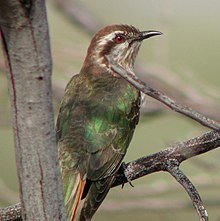Horsfield's bronze cuckoo
| Horsfield's bronze cuckoo | |
|---|---|
 |
|
| Scientific classification | |
| Kingdom: | Animalia |
| Phylum: | Chordata |
| Class: | Aves |
| Order: | Cuculiformes |
| Family: | Cuculidae |
| Genus: | Chrysococcyx |
| Species: | C. basalis |
| Binomial name | |
|
Chrysococcyx basalis (Horsfield, 1821) |
|
The Horsfield’s bronze cuckoo (Chrysococcyx basalis) is a small cuckoo in the family Cuculidae. Its size averages 22g and is distinguished by its green and bronze iridescent colouring on its back and incomplete brown barring from neck to tail. What distinguishes the Horsfield’s bronze cuckoo from other bronze cuckoos is its white eyebrow and brown eye stripe. The Horsfield’s bronze cuckoo is common throughout Australia preferring the drier open woodlands away from forested areas.
The Horsfield’s bronze cuckoo is one of five Australian species in the genus Chrysococcyx (formally Chalcites) a type of parasitic bird, that parasitises fairy-wrens primarily to raise their young.
The five species of cuckoo in the genus Chrysococcyx:
The main diet of the Horsfield’s bronze cuckoo is insects and they are nomadic, travelling to different regions of Australia to breed and find food. Small insects are taken from leaves, branches, caught on the wing and in breeding season, Horsfield’s bronze cuckoos feed each other in a courtship ritual.
The Horsfield’s bronze cuckoo is known as a brood parasite, this means that they lay their eggs in a host species nest. They mainly parasitise the fairy-wrens in the genus Malurus. It has been well documented that the superb fairy-wren (Malurus cyaneus) and the splendid fairy-wren (Malurus splendens) are the two main species to bare host to the Horsfield’s bronze cuckoo, although they may also parasitise other small Passeriformes including thornbills, warblers and scrub-wrens that can be utilised as a secondary host in certain locations. Although the behavioural attributes of a host species may play a role in parasitism, it is thought that the female selects its host through imprinting, remembering the species that it was raised by and ultimately using that species to raise its brood.
The Horsfield’s bronze cuckoos are known to form monogamous pairs in the breeding season and occupy the same breeding territories as their host species, however partnerships are short lived as a female will only occupy the breeding territory for a few weeks, as another female takes her place, she may form a pairing with the same male. Females that leave a breeding site after several weeks may move to another site and continue to breed with another male, forming another bond in a new breeding territory. Breeding territories of the Horsfield’s bronze cuckoo generally do not overlap giving rise to the possibility that a pair will defend an area through the season.
...
Wikipedia

